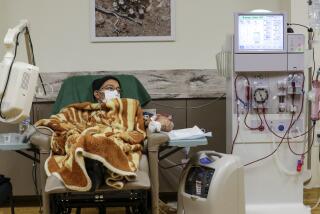For-Profit Dialysis Sites a Risk to Patients, Report Says
- Share via
Private for-profit kidney dialysis centers may provide worse care for patients than private centers that are not-for-profit, resulting in about 2,500 premature deaths in this country every year, scientists report today in a new analysis of patient data.
A likely cause, according to the authors, is the need by for-profit centers to pay taxes and make money, which could lead companies to reduce staff, employ less-qualified workers and cut the time a patient spends in dialysis.
The study, published in the Journal of the American Medical Assn., pooled data from eight previously published studies and found 8% more deaths each year with for-profit institutions than with not-for-profit private institutions.
About 75% of people requiring dialysis for kidney failure in the United States receive their care at for-profit dialysis centers. “The study suggests that one should seriously rethink whether for-profit health care should be delivered or allowed,” said Dr. Holger J. Schunemann, assistant professor of social and preventive medicine at the University of Buffalo and a co-author on the study.
However, several scientists commenting on the study expressed doubts about its findings, in part because it was based on information collected from 1973 to 1997 that could be outdated by modern practices.
“It’s kind of a stretch,” commented Philip Held, adjunct professor of internal medicine at the University of Michigan in Ann Arbor and founder of the University Renal Research and Education Assn., a kidney research foundation.
“Even if what they say is true -- and I’m not very convinced by what they report -- it’s history. It borders on ancient history.”
Several studies using more recent data have found no significant difference between for-profit and not-for-profit dialysis centers, Held said.
Kent Thiry, chief executive of Torrance-based DaVita Inc., which provides kidney dialysis to 44,000 patients in the United States, said the study published today was “very frustrating, because there’s no new data, and a lot of the data being used has been discredited.”
The study, led by Dr. P.J. Devereaux of McMaster University in Canada, selected eight research papers that had tracked more than 500,000 patients in the United States. The researchers selected only private for-profit and not-for profit centers, omitting public dialysis centers because they account for very few of the procedures performed each year.
Six of the studies reported increased mortality at for-profit centers. The remaining two studies showed no significant differences.
“It’s kind of scary: You always worry that your patients are not being taken care of ... that someone’s shaving the edges,” said Dr. Elaine Kamil, clinical director of pediatric nephrology at Cedars-Sinai Medical Center and president of the medical board of the National Kidney Foundation of Southern California.
However, she added that dialysis practices have markedly improved in recent years. In 2000, the National Kidney Foundation created a set of dialysis guidelines covering every aspect of patient care, from how long to give someone dialysis to managing the anemia that patients with kidney failure often experience.
“As far as I know, the guidelines have been uniformly adopted across the country, and I think that it’s really impacted dialysis care,” Kamil said.






